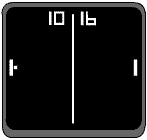A History of Computer Games
Created | Updated Jan 20, 2014

One morning in 1958, at the Brookhaven National Laboratory in Upton, New York, USA, a researcher named William Higinbotham was working with a vacuum-tube analogue computer. It was a slow day, so, to liven things up a bit, he connected a few modules together and managed to display bouncing balls on his screen. He thought it would make a good game, so he created a simple tennis simulation and built in an upside-down 'T' used as the net. Thus the first computer game was born. Sadly, being all hardware, it was dismantled in 1960.
In 1962, Steve Russell, a researcher at the Hingham Institute in Cambridge, Massachusetts, came up with Spacewar - a two-player game featuring torpedo-firing spaceships. By 1969, when Steve Russell had transferred to Stanford University, Spacewar had become a huge hit with visiting engineering students, one of whom was Nolan Bushnell.
Bushnell was working at a theme park while studying electrical engineering at university and he thought it might be an idea to try and use a computer in an amusement arcade. He spent his spare time designing a commercial version of Steve Russell's Spacewar, which he called Computer Space. Nolan Bushnell's game was the first coin-operated computer game in the world. The year was 1971.
Later that year, a games manufacturer called Nutting Associates bought the rights to Computer Space for $500 and produced 1,500 machines. Nolan Bushnell sat back and waited for the coins to start rolling in, but Computer Space was a complete flop. Luckily, Bushnell realised why: even though the technology was there to produce far more complicated games than his, the average person had no concept of how to control things on a television screen. They needed to be eased into it gently.
Using the $500 he had earned from Computer Space, Bushnell started his own company called Atari. He hired an engineer named Alan Alcorn to programme the simplest computer game imaginable. He game up with a game called Pong. Pong was nothing more than two movable rectangles on either side of a screen, which the two players used to bounce a little ball back and forth over a central dividing line. Bushnell's latest game was turned down by every games manufacturer he went to.
Undeterred, he put his prototype game in a corner of Andy Capp's Bar in Sunnyvale, California. Bushnell was phoned at the end of the first day and was told the game had broken down. When he went to fix it, he found the problem immediately - the coin box was overstuffed with quarters. Computer games had arrived.
By 1981 Atari had become the fastest growing company in American history, but Nolan Bushnell had already sold his $500 company to Warner Communications in 1976. He did make a handsome profit, though - he sold it for $28 million.

